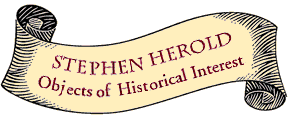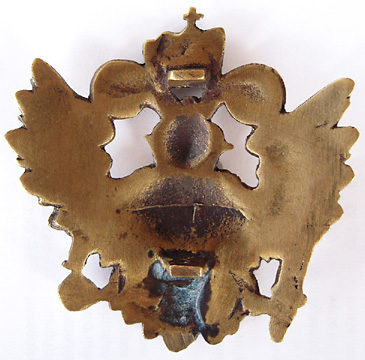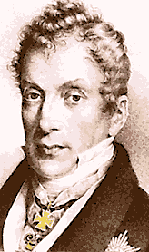

A
very high quality and rare solid gold European hallmarked miniature of the Order
of St. Esprit, the highest of the French Royalist orders. Like all the greatest
orders there were very few members of the St. Esprit as it was limited to the
King and 112 members. One had to be a member of the Order of St. Michael before
joining the St. Esprit, and the order was mostly seen at formal occasions. Founded
on December 31, 1578, the new order was reserved for princes and powerful nobles,
whilst the old Order of Saint Michael would be given to less eminent servants
of the Crown. This Order was dedicated to the Holy Spirit for commemorating
fact that Henry was elected King of Poland (1573) and France (1574) on two Pentecosts.
During
the French Revolution the Order of the Holy Spirit was officially abolished
by the French government along with all other chivalric orders from the Ancien
Regime, although the exiled Louis XVIII continued to acknowledge it. The Revolutionary
government also called for all existing badges to be turned in so they could
be melted down for coinage, increasing the scarcity of such items. Following
the Restoration, the order was officially revived, only to be abolished again
by the Orleanist Louis-Philippe following the July Revolution in 1830. However,
the Legitimist pretenders to the French throne have continued to nominate members
of the order, long after the abolition of the French monarchy itself.
Miniatures are not known until late in the history of the order and all seem to date to the late 18th or early 19th centuries. This is a 19th century fully hallmarked miniature that is European made. It has both a maker’s mark and a 585 gold purity hallmark. In years of looking and collecting I have only seen one other fine miniature of the St. Esprit, a European made one in silver and old mine cut pastes dating to c. 1820 and now in a private American collection.
EF condition
$400.00
A
complete bijou of the Spanish Golden Fleece in silver-gilt fom the middle to
late period of Alphonso XIII through Franco, and most likely made between 1930
and 1975. Of the Spanish Fleeces that we have seen this is one of the very finest,
with high quality workmanship, a creative design and a light blue sapphire in
the Pierre a Fois. The Fleece is in the Spanish profile manner and is in full
round, but the other elements are uniface as is normal with Spanish Fleece insignia.
The briquette is an elaborate Hispano-Moorish style of knotted “B”s with finely
engraved edges, and the flames are exceptionally modeled and complex for modern
Spanish bijous. The cut ball pivot for the Fleece hints at French workmanship,
as does the Art Nouveau briquette design. Contemporary and likely original cravat
ribbon.
This one seems unworn and likely came from old dealer's stock. The elements are elegant and decorativein appearance. When the number of Spanish members declined after the Civil War and was not revived as a social order after the return of Juan Carlos, such speculative manufactures remained unsold and so are the last official bijous to be issued.
Excellent condition
$1,750
An
unusal and scarce mid 19th century bronze-gilt bijou of the Austrian Order of
the Golden Fleece. The knot, briquette and flames are made from the standard
dies of authorized imperial jewelers, and to the slightly smaller form used
prior to 1860 or so. The upper pieces are also elaborately engraved with detail
as in all proper bijous. The fleece is of an elongated variety usually seen
in bijous of French manufacture, and the ram’s head is starting to turn
3/4 left as in the later Austrian fleeces. It also is in full round two sided
form as with all real uniface bijous. It has no official cravat ribbon, but
does come with an old length of red ribbon.
The bijou has extensive patina from long use, and the enamel is wearing a bit on the highlights of the flowing, three dimensional flames. The only improper part of the piece is a later replacement base metal strap that holds the fleece to the flames, and it should be replaced in gold.
It’s provenance is from
a Hungarian dealer. He obtained it from the sale by a Vienna Theater of all
costumes and props when they lost the use of their building which they had had
for a century. The theater purchased the item on the Vienna second hand market
generations ago; most likely in 1920-1940.
Austrian bijous have become almost unavailable in recent years, and even the Spanish ones have more than doubled in price, when available. I have seen only two 1900-1920 period Austrian bijous in the last three years, and they sold at auction for some $6,000. These uniface bijous were made to save both the cost and the weight of gold ones. In the 20th century almost all Spanish bijous were uniface, as were almost all jeweled bijous.
In addition to such wearing copies there were a dozen or so reproductions made in 1898 by the Imperial Austrian government for use in dramatic events of the celebrations. These, I learned in Vienna this year, are even more scarce than official bijous and sell for the same price when available. I know of no such older “collector’s copies" in this style in bronze gilt, especially since making them was illegal until 1920 and the end of the monarchy. Silver gilt became standard for European orders in the 1880s, and all modern reproduction pieces I have seen are so, or obviously cheaper pieces.
Another possibility is suggested by the Hungarian dealer who obtained this order from the theater. He reports: "Incidentally, a few years ago I had 3 Austrian decorations that were quite mysterious. They were not very nice quality, one-sided and had prongs on their reverses (there was a Franz Josef Order, and two others). I just thought that they were some kind of cheap copies, but it turned out that they were copies made for funerals, to be buried with the recipient!" An interesting story but not so here since this piece is far from a"cheap copy". Then an Austrian historian mentioned that such single face orders were made for wear in combat, and showed me a photo of Emperor Karl seemingly wearing one. This seems the most likely origin for the unifce Austrian fleeces. No matter how much we learn there is always more to know.

Size is 14.8 cm overall height, 7.3 cm maximum width at the flames, and the fleece is 5.8 by 4.3 cm.
Fine to VF condition.
$1,750.00
When
the Canon and Civil merit Crosses were issued in 1814 two special, large crosses
were also awarded. There was a military cross for FM Schwarzenberg and a civil
cross for Prince Metternich. The Schwarzenberg cross is in the Military Museum
in Vienna, but the Metternich cross has not been seen since he fled Vienna in
the Revolution of 1848. For display a very few museum copies have been made
in silver-gilt, of which this is one. I have heard of them before, but this
is the only one I or my friends have seen in 40 years. It would be worn on the
civil cross ribbon of a wide black stripe between two gold ones, and some paintings
and engravings of Metternich show it worn thus (one shown below).
Near EF condition with proper grooved ribbon ring, but no ribbon.
$250.00

During the War of 1812 with the British raiding along our coastlines, it was decided in New Haven to form a second company of Light Infantry to protect New Haven. On September 13, 1816 the New Haven Grays were formed from members of the New Haven Militia and new recruits. They elected Shapos Staples to be their commander. Their motto was "Semper Fidelis" as with with the Marine Corps. Until the Civil War their service was mainly to control local riots and Yale student-citizen troubles. In one case, a young woman form West Haven, died and was buried. The following day it was discovered that her body had been taken by some medical students at Yale Medical School for research. Armed with a small cannon and muskets, the outraged citizens marched on Yale. The mayor called out the Grays who quickly took control of the situation. The body was returned and peace was restored. Another incident occurred with the citizens of Fair Haven, a small fishing community in New Haven, the "Yalies" were chasing after the young women of Fair Haven, and the village fathers demanded it stopped, at a meeting it was decided to take steps to stop the "Yalies." Again armed with a small cannon and muskets they marched on Yale. The Grays were again called upon and peace and quiet were soon restored.
They
later served in the Civil War. The unit took part in 19 battles during the Civil
War beginning with Bull Run, and at Gettysburg several monuments stand today
in honor of those men and their deeds. They also served on the Mexican Border
with Pershing, in WW I, WW II and Korea. They are still active today and are
HHC 1st Battalion 102nd Infantry Regiment of the army national guard.
This very rare members pin is handmade from sheet gold and enamel and, by its style and that of the name engraved on the back, is pre Civil War and possible dating to the very origins of the unit in 1816. On the back it is named to the owner, a Mr. C.S. Lee with his address on Goff Street. War of 1812 items are very scarce and New Haven Grays ones almost unknown, making this a most special pin. I have researched the city directory for New Haven and, although a C.S. Lee is not found Mr. Edwin Lee is and is likely a close relative, either father, brother or son. Mr. Edwin Lee was a well known and respected carriage maker who lived at several locations in New Haven from 1840 until his death in the 1870s, one of which was on Goff Street. His widow lived in New Haven for several years thereafter. Much more research is possible since the city directory only lists businesses and property owners.
EF condition. It is about an inch square and although unmarked seems to be about 14 K solid gold.
$800.00